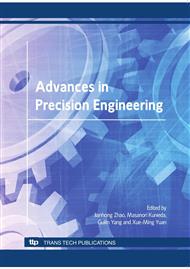p.341
p.346
p.351
p.356
p.361
p.366
p.371
p.376
p.381
Comparing Microgroove Array Forming with Micropyramid Array Forming in the Glass Molding Press
Abstract:
This paper presents a glass molding press (GMP) method to fabricate microgroove array and micropyramid array on the glass plate by replicating the shape of the mold to the glass surface. The differences between microgroove forming and micropyramid forming were investigated by experiments and finite element method (FEM) simulations. Microgroove arrays and micropyramid arrays were generated on the flat glass plate in the GMP process by using an electroless-plated Nickel Phosphorus (Ni-P) mold, on which the microstructures are fabricated by micro cutting. Furthermore, FEM simulations were used to trace the stress distribution and the strain distribution during the glass deformation, which illustrates the glass material flow in the microgrooves and the micropyramids on the mold during pressing. By comparing the processes between microgroove forming and micropyramid forming, the differences between them observed in the experiments were explained by the simulation results. Finally, some techniques to improve the forming accuracy were proposed.
Info:
Periodical:
Pages:
361-365
Citation:
Online since:
September 2010
Authors:
Price:
Сopyright:
© 2010 Trans Tech Publications Ltd. All Rights Reserved
Share:
Citation:


